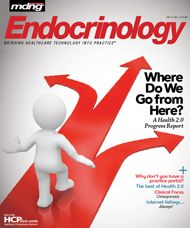5 Questions ...with Rishi Shah, CEO of the Diabetes Health Network
Shah discusses the services offered by the Diabetes Health Network and explains the benefits of offering educational resources to patients while in the waiting room.
Shah discusses the services offered by the Diabetes Health Network (DHN) and explains the benefits of offering educational resources to patients while in the waiting room.
1. How did DHN come about?
The Diabetes Health Network was founded to help healthcare professionals educate and inspire their patients during their medical visit, specifically during their wait time. Therapies are advancing rapidly, and we have all these new cool technologies, but patient care, satisfaction, and knowledge is not expanding at the same rate. Physicians are not able to spend an hour with each patient during every appointment. They need a way to save time but still address all the important healthy lifestyle issues. The Diabetes Health Network provides physicians with a free flat panel display for their waiting area that becomes their own personal TV channel that they can control. Th ey can make changes to the programming and customize the system to better suit their patient demographic and needs.
2. How much do these services cost?
The flat panel display and services are provided free of charge. When we set up a pilot study of about 50 endocrinologists, we learned that doctors loved the service, but they did not have a waiting room budget to support it. Although they felt the service was worthy, and patients loved it, they were not going to be able to pay much for it. Because we wanted to build a state-of-the-art network, powered by broadband and with a computer on the back of each display, this was an expensive project. We realized that we were going to have to come up with another funding mechanism. We made sure that physicians would not have to pay for anything by setting up a traditional media model in which the viewer is not paying for the content, but we have a broad array of sponsors that get a little bit of airtime on the network, much like a regular television network.
Another thing that tends to prevent patient education resources like ours from reaching patients is fear of a minimum term commitment. We eliminated this by giving physicians the right to cancel our service anytime. Physicians can request our service for a week, a month, a year, or even just for a day. If they feel like it’s not serving their needs, we will come to their clinic and remove the system at no cost.
Many times physicians will see great patient education resources but think to themselves, “I’ll do this when I have a little more time.” As a result, we made sure the DHN is extremely easy to set up and doesn’t require anything of physicians except the introductory phone call. In addition, DHN TV saves the physicians a lot of time. They’re answering questions before they even say hello to their patient by playing comments about lifestyle, nutrition, and fitness in the waiting room. The program doesn’t require an investment from the physician, in terms of time or money, and it produces immediate results that help them have a better practice and also greatly improve the patient’s experience.
3. Who is eligible for these services?
All diabetes, endocrinology, and other medical offices qualify as long as at least half their patients are diabetic, their average wait time is at least 15 minutes and they see at least 75 patients per week. We want to make sure that this is a good idea to put in your waiting area. We don’t want to make such a large investment if there are not enough diabetics there, because your patient population isn’t going to be all that interested in the programming. Other than that, it’s open to all endocrinology and diabetes clinics in the United States.
4. Do you maintain the system?
We take care of 100% of the maintenance of the equipment and everything else related to the system. Physicians can work with their designated member services executives (account managers) to be as much or as little involved as they want—they can pick the type of programming they want, add their own clinic slides, or remove any programming they don’t like. An example is our Hispanic programming loop which features culturally relevant recipe segments and health tips. We also have a special programming loop available for pediatric endocrinologists, since educating kids requires a diff erent kind of content. Physicians can also do it on their own by going to the website and filling out a clinic slide form online. We’ve found that physicians and diabetes educators, as much as they love technology, often feel that it misses a human touch—somebody to work with that could implement that change for them. That’s why we give each office their own dedicated member services executive.
5. What other services does DHN offer?
DHN TV had a wonderful reception from clinics and patients, but what they really asked for next was a way to take the information they saw on the TV home with them. Th at is why we started offering our DHN literature holders to all our member clinics. These literature holders carry information from our content partners such as JDRF and dLife, and also from federal agencies. We also piloted a sampling program, offering foot balm samples to our clinics. It’s very convenient for patients to be able to see something on the DHN TV, read about it by picking up a brochure, and also take some home to try it out.
